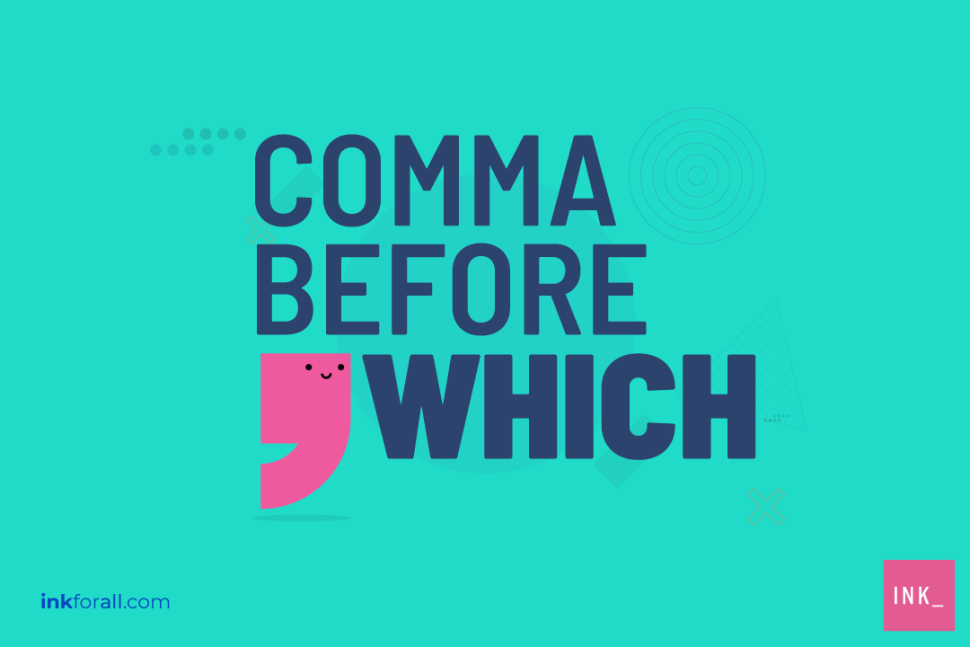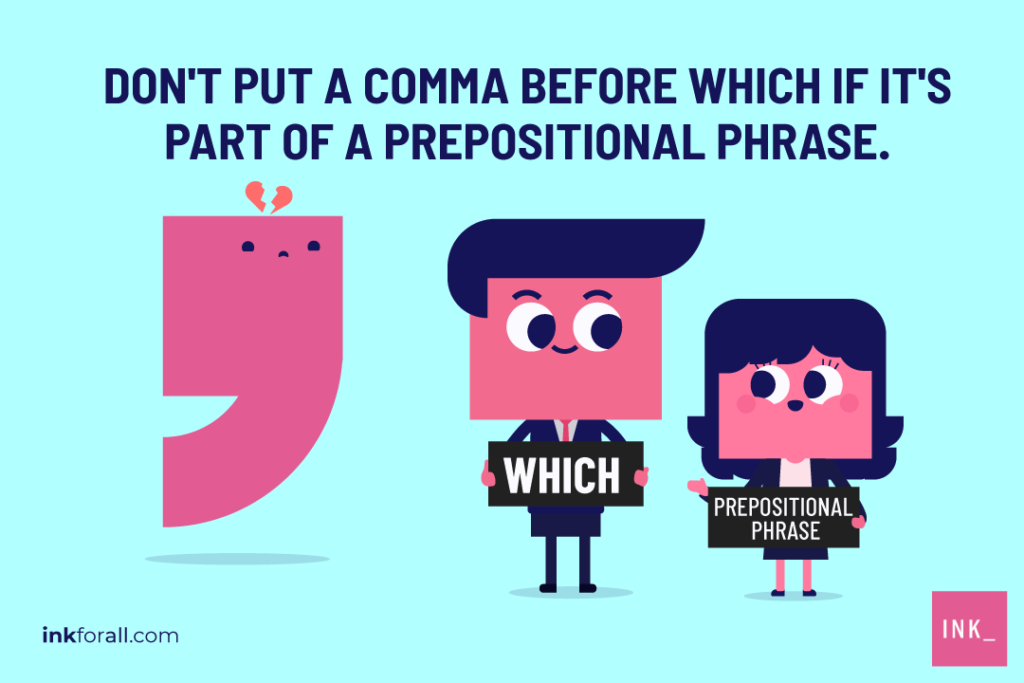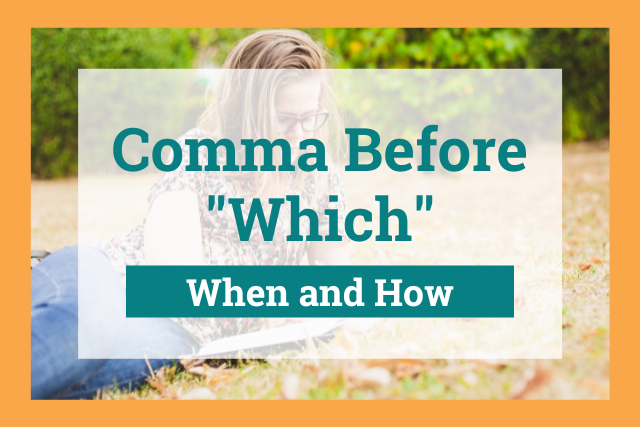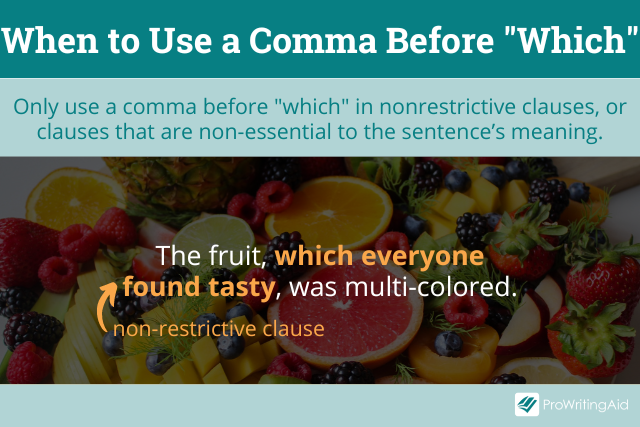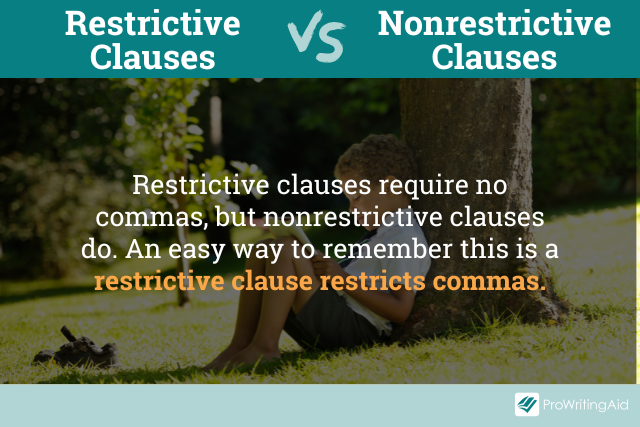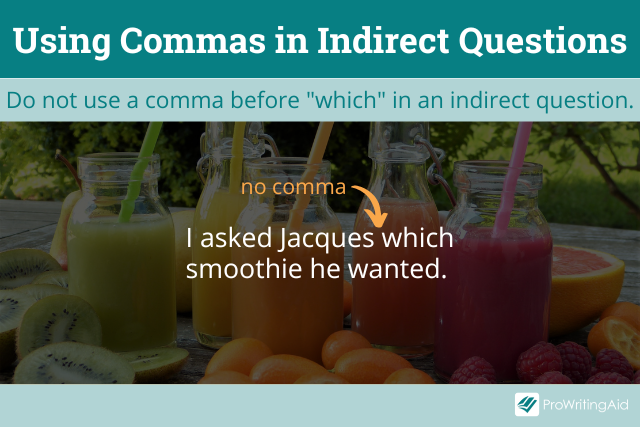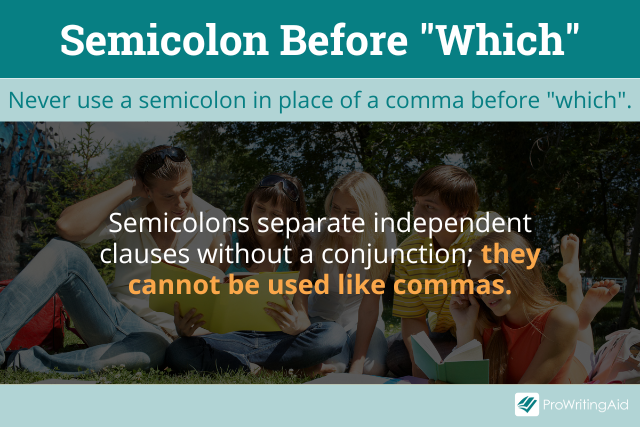1) Do not place a comma before «that»; 2) Do not place a comma before who or which if the information provided by the relative clause is essential; 3) Place a comma before who or which if the relative clause is not necessary to know who or what the speaker means.
When using the relative pronoun «who«, «which«, or «that» in a sentence:
- Do not place a comma before «that«:
The man that lives next door is tall.
The man, that lives next door, is tall.
-
Do not place a comma before «who» or «which» if the information provided by the relative clause is essential to understand which person or thing the writer is talking about.
The man who lives next door is tall.
The man, who lives next door, is tall.
We need the relative clause «who lives next door» to know exactly who is the man the writer is talking about. We do not use commas in a situation like this.
-
Place a comma before «who» or «which» only if the relative clause is not necessary to know who or what you are talking about. That is, the relative clause provides additional information about the person or thing, but this extra information is not essential to identify the subject.
My neighbor Peter, who lives next door, is very tall.
Even if you omit the clause «who lives next door», the reader knows who you are talking about (your neighbor Peter). The clause «who lives next door» just adds extra information.
When someone or something is sufficiently identified, the description that follows is considered nonessential and should be surrounded by commas.
Contents
- 1. Using Commas with Relative Pronouns
- 2. Using a Comma Before ‘Who’ or ‘Which’ Changes the Meaning of a Sentence
- 3. When to Use ‘That’, ‘Who’ and ‘Which’
- 4. More Examples
1. Using Commas with Relative Pronouns
Look at this example:
People who live in cities are more stressed.
«Who live in cities» is a relative clause (a part of the sentence that tell us what type of person or thing the speaker means). Relative clauses begin with relative pronouns, such as «who«, «which«, or «that«.
The children who read at home regularly make the most progress.
The clause «who read at home regularly» is essential to understand the meaning of the sentence. If we omit this clause, the sentence makes no sense.
The children make the most progress.
The sentence above is incorrect since we are trying to say that only some students, those who read at home regularly, make the most progress.
Another example:
My brother, who works as a dentist, is wealthy.
If we take out the relative clause («who works as a dentist»), the sentence is complete and makes sense. It also provides the most relevant information (My brother is wealthy.)
When using a comma before «who» or «which», include also the closing comma (the comma after «dentist» in the example above). Some writers forget to add this important comma. At the end of a sentence, a period replaces a comma.
2. Using a Comma Before ‘Who’ or ‘Which’ Changes the Meaning of a Sentence
Examine this example:
My sister, who is very tall, can speak English and French.
This sentence is correct because you are assuming that the reader knows who you are talking about (your sister).
However, if you have two sisters, the reader may need to know which sister you are speaking about. Remember, we should avoid commas if the information is essential to know who or what you are talking about:
My sister who is very tall can speak English and French.
Another example:
I’m planning to go to Spain which is very sunny next month.
In this sentence, the comma is not optional. The clause before the relative pronoun tells us where you are going (Spain). In this particular context, the relative clause «which is very sunny» just adds extra information about Spain.
I’m planning to go to Spain, which is very sunny, next month.
- We use «who» for people (sometimes for animals too).
She doesn’t like people who get angry easily.
I don’t like movies who have scenes of violence.
- We use «which» for things.
I only buy watches which are waterproof.
My uncle, which is an engineer, went to London last week.
- We use «that» for people or things.
The girl that came last week is smart.
The dish that you prepared yesterday was delicious.
- «That» is more common than «which«, but sometimes you need to use «which» (see next point).
Rebecca works for a company that makes drones.
I don’t like movies that have scenes of violence.
- If the sentence requires commas, you should use «which» for things and «who» for people (not «that»).
Madrid, which is the capital of Spain, was founded around the year 860 A.C.
Alex, who is very tall, is a good chess player.
- In many situations, you can omit the pronoun in a relative clause. You can learn more about how to omit correctly that, who, or which.
Remember, we don’t put a comma before that.
Paris, that is the most romantic city in the world, is a beautiful place to live.
Paris, which is the most romantic city in the world, is a beautiful place to live.
Another example:
Rebecca, that lives in New York, is very smart.
Rebecca, who lives in New York, is very smart.
4. More Examples
Examples with «who«:
- The waiter who served us was rude.
- What was the name of the person who came yesterday?
- The man who was carrying a suitcase was very polite.
- My friend Olivia, who lives next door, is an engineer.
- What was the name of the person who wanted to talk to you?
- The police caught the girl who stole the wallet.
- Marie Curie, who was the first woman to win a Nobel Prize, discovered the existence of the elements polonium and radium.
- The movie was about a boy who was raised in Paris.
- A firefighter is a person who fights fires and rescues people.
- Do you know who took those pictures?
Examples with «that«:
- The restaurant that was destroyed in the fire has now been rebuilt.
- The protester that was arrested has hired a new lawyer.
- What happened to the hamburger that was on the table?
- A paradox is a statement or proposition that is seemingly contradictory.
- Andorra is a microstate that borders France and Spain.
- Thailand is the only Asian country that was never colonized by a European country.
- The company that was fined for air pollution is now investing in renewable energy.
Examples with «which«:
- Artificial intelligence, which combines computer science and robust datasets, enables the execution of complex tasks.
- The new stadium, which can hold 20,000 people, has an oval shape.
- We often go to Chicago, which is not far away.
- Inflation, which is pretty high right now, is having an impact on US consumers.
- Yoga, which improves core strength and flexibility, is very popular in India.
-
EM
-
Articles
-
Punctuation
-
Pronouns
Summary
No comma is needed before or after the word that, whether used as a relative pronoun or a conjunction.
Examples
- Incorrect: The parcel, that came this morning contained seeds.
Correct: The parcel that came this morning contained seeds. - Incorrect: Today I learned that, islands are mountains in the sea.
Correct: Today I learned that islands are mountains in the sea.
Use a comma before which when it introduces a nonrestrictive clause (one that provides extra, optional information). Remember to use a comma both before and after the which clause.
Example
- Incorrect: This shirt which I ordered online is the wrong size.
Correct: This shirt, which I ordered online, is the wrong size.
Which can replace that to introduce a restrictive clause, providing information essential to meaning. Commas are then omitted. (Such use is seen more often in British than American usage.)
Example
- Incorrect: Oceanic islands are islands, which do not sit on continental shelves.
Correct: Oceanic islands are islands which do not sit on continental shelves.
Finally, no comma is needed before or after which when it is used after a preposition or in an indirect question.
Examples
- This is a story in which nothing happens.
- They asked which flight we had booked.
That and which
The words that and which are relative pronouns that help describe nouns. Commas are used depending on whether the description is essential to meaning or whether it merely provides additional, optional information.
Examples
- Cats that like cheese love pizza.
- I have a shirt that might fit you.
- Such medicines, which relieve acidity, are called antacids.
- Anita got a job in Paris, which is what she wanted.
That and which also have other uses. That can be used as a conjunction to introduce a subordinate clause. Which appears in prepositional phrases (in which, on which) and indirect questions.
Examples
- Anita said that she wanted to go to Paris.
- The house in which she lived was built in 1913.
- Ask Tumkin which pizza he wants.
In this article, we discuss when to use commas with that and which.
Comma with that
No comma is needed before or after the word that. As a relative pronoun, that introduces a restrictive clause, which contains a description necessary to identify the person or thing being referred to. Since such information is essential to meaning, it is not enclosed in commas.
Examples
- Incorrect: Cars, that run on solar power, are better for the environment.
“Cars are better for the environment” doesn’t convey complete meaning. Which cars? The ones
that run on solar power
. That introduces a clause essential to meaning; don’t enclose it in commas.
Correct: Cars that run on solar power are better for the environment.
- Incorrect: Here is a list of fruits that, last forever in the fridge.
Correct: Here is a list of fruits that last forever in the fridge. - Incorrect: Elephants are mammals, that can’t jump.
Correct: Elephants are mammals that can’t jump. - Incorrect: Your website should have a URL, that’s memorable.
Correct: Your website should have a URL that’s memorable.
Tip
Don’t use commas around any description essential to meaning (whether or not you use the word that).
Example
- Incorrect: The phone, I bought online is broken.
Which phone? The one
I bought online
.
Correct: The phone I bought online is broken.
The word that is also used as a conjunction to introduce a subordinate clause. Again, no comma is needed before or after that.
Examples
- Farley thought that dragonflies were baby dragons.
- Lulu said that she wanted more cake.
- I’m glad that you called.
A comma may be used after that if it is followed by an interrupter or other parenthetical phrase.
Examples
- Anita said that, all things considered, she prefers tea to coffee.
- We wanted a car that, in the long run, would do less harm to the environment.
- It was a parcel that, surprisingly, contained seeds.
Comma with which
Use a comma before which when it introduces a nonrestrictive clause (an additional, optional description) in a sentence. Such information may be interesting and even useful but is not essential to meaning. It is therefore enclosed in commas.
Examples
- Incorrect: Farley’s new phone which he bought just yesterday has already stopped working.
Even without the which clause, we know which phone is being referred to:
Farley’s new phone
. Enclose the extra information in commas.
Correct: Farley’s new phone, which he bought just yesterday, has already stopped working.
- Incorrect: She comes from Pouthena which is the capital of Nusquam.
Correct: She comes from Pouthena, which is the capital of Nusquam. - Incorrect: This recipe calls for seven eggs which makes no sense at all.
Correct: This recipe calls for seven eggs, which makes no sense at all.
Caution
Remember to use a comma not just before but also after the which clause.
Example
- Incorrect: This phone, which I bought ten years ago still works fine.
Correct: This phone, which I bought ten years ago, still works fine.
The relative pronoun which can also replace that to introduce defining or restrictive clauses (which provide information essential to meaning). Commas are then omitted.
Examples
- The flowers which came this morning are for you.
- The house which Farley built has fallen down.
- One of the marbles which were here is missing.
Note
In formal British usage, which is preferred over that in restrictive clauses (information essential to identify the person or thing being referred to). In contrast, in edited American prose, that is preferred over which.
Example
- Formal (British): Penguins are birds which cannot fly.
Formal (American): Penguins are birds that cannot fly.
Don’t use a comma before which when it acts as the complement of a preposition (in which, of which).
Examples
- Incorrect: The parcel in, which the seeds arrived had no label.
Correct: The parcel in which the seeds arrived had no label. - Incorrect: The book on, which this movie is based was written by a friend of mine.
Correct: The book on which this movie is based was written by a friend of mine.
Also don’t use a comma before which in indirect and reported questions.
Examples
- Incorrect: Lulu asked me, which book I wanted.
Correct: Lulu asked me which book I wanted. - Incorrect: I wonder if you know, which bus I should take.
Correct: I wonder if you know which bus I should take.
Examples from literature
The following examples show how that is used to introduce an essential clause. No commas are necessary or used.
Examples
I’ve never come across a definition that satisfied me, though there are some very good ones.
I was young and not gloomy and there were always strange and comic things that happened in the worst time.
In these sentences, that is used as a conjunction to introduce a subordinate clause. Again, no commas are needed.
Examples
And I knew that it was better to live out one’s absurdity than to die for that of others.
In university they don’t tell you that the greater part of the law is learning to tolerate fools.
Note how a comma is used before which when it introduces an optional, nonessential description.
Example
Pink is supposed to weaken your enemies, make them go soft on you, which must be why it’s used for baby girls.
Finally, when which is used in place of that to introduce a restrictive clause (one that provides information essential to meaning), no commas are used.
Example
But there was happiness elsewhere which no description can reach.
Usage guide
Don’t use a comma before or after the word that, either as a relative pronoun (when it introduces information essential to meaning) or as a conjunction (when it introduces a relative clause). The word which is also used as a relative pronoun, but it generally presents an optional description, which you should enclose in commas (remember to use commas both before and after the which clause). In British usage, which often replaces that to present information needed to identify the person or thing being referred to; commas are then omitted. When which is used with a preposition (of which, in which), no comma is needed before or after the word. Finally, don’t use a comma with which when it appears in an indirect or reported question.
Examples
- Correct: That as relative pronoun: Tree kangaroos are marsupials that live in trees.
- Correct: That as conjunction: You thought that tree kangaroos weren’t real.
- Correct: Which as relative pronoun (nonrestrictive): Tree kangaroos, which look like a cross between a kangaroo and a lemur, are found in Australia, Indonesia, and Papua New Guinea.
- Correct: Which as relative pronoun (restrictive): They are marsupials which have evolved to live in trees.
- Correct: Which as complement of preposition: Here is a list of countries in which tree kangaroos are found.
- Correct: Which in indirect question: She wanted to know which animal I was talking about.
Main Takeaways:
- Place a comma beforewhich when which precedes a nonrestrictive clause.
- A nonrestrictive clause is a phrase that adds non-essential information to a sentence without changing the overall meaning.
- Don’t place a commabeforewhich when which is part of a prepositional phrase.
- Don’t use a commabefore which when it’s used to pose an indirect question.
- We use which with nonrestrictive clauses, while we use that with restrictive clauses.
- When used with a restrictive clause, you don’t need to put a commabeforethat.
- Restrictive clauses function as identifiers. Removing a restrictive clause from a sentence changes the sentence’s meaning.
Whether to use a comma before or afterwhich in a sentence is a dilemma that many people face when writing. This grammar guide will teach you when you should and shouldn’t place a comma before which.
When it comes to grammatical conundrums, commas are often the culprit. Thankfully, learning when to use a comma before and afterwhich is actually pretty easy when you follow several simple rules.
When Should You Use a Comma Before Which?
Simply put, you should use a comma beforewhich when it precedes a nonrestrictive modifying clause. A nonrestrictive modifying clause is a phrase that adds nonessential information to a sentence without altering its meaning. It’s normally set off from the rest of a sentence with commas.
In this example, the phrase “which can be difficult to use correctly” is the nonrestrictive modifying clause. It modifies the noun comma, letting us know that commas can be challenging. Without it, however, the primary meaning of the sentence would remain intact.
In the example above, the sentence is correctly punctuated with a comma beforewhich. Another comma, placed after “correctly,” sets the phrase completely apart from the rest of the sentence. This is typical of nonrestrictive clauses.
Note: Nonrestrictive modifying clauses are also known as nonessential clauses or parenthetical expressions.
Should Which Always Be Preceded By a Comma?
The quick answer to this question is no. A comma should always precede which when it introduces a nonrestrictive clause. Otherwise, don’t place a comma prior to which.
There are several other ways that which can be used in a sentence. None of the following ways require a comma before which.
1. When Which Is Used in Prepositional Phrases.
Sometimes which forms part of a prepositional phrase. A prepositional phrase includes a preposition and a noun or pronoun that serves as the object of the preposition. It may also include adjectives that modify the object.
When which appears in prepositional phrases, it’s typically paired with a preposition.
- in which
- on which
- during which
- after which
- from which
When used this way, you don’t need a comma before the which.
2. When Which Forms a Question
Since sentences never begin with commas, it should go without saying that you don’t need one before which when it starts a sentence.
After all, it would look pretty strange if it was written as:
There is, however, another potential scenario when which forms a question. That’s the indirect question. In this scenario, a question is implied rather than asked outright. There is no question mark at the end of the sentence in indirect questions (unless they’re embedded in another question).
Essentially, both examples are asking about what items are on sale. One asks directly, while the other poses the question indirectly.
Comma After Which
Some grammarians believe that a comma can be used after which for reasons of style.
You’ll notice here that by adding a comma after the which, you end up with commas before and after it. This can lead to a choppy sentence. In this case, rephrasing may be the better option.
That vs. Which: Picking the Right Word
When learning how to punctuate a sentence using the word which, it’s important to understand when which isn’t the right word at all.
One Rule to Guide Them All
It’s easy to get tangled up choosing between that and which, but there’s a simple rule for picking the right word. That is used with restrictive clauses. Which is used with nonrestrictive clauses.
Restrictive Clauses
To simplify, restrictive clauses provide essential descriptive information about the noun they modify. They function as identifiers, essentially narrowing things down. They can’t be removed from a sentence without altering the meaning.
The restrictive clause in this sentence, “that are well-trained,” modifies the noun—in this case, dogs. This clause narrows it down to a specific category of dogs: well-trained dogs. You can’t remove the clause without altering the sentence’s essential meaning. That makes it a restrictive clause.
When used this way, there’s no need to place a comma before that.
Nonrestrictive Clauses
As discussed earlier, nonrestrictive clauses add non-essential information to a sentence. Unlike a restrictive clause, a nonrestrictive clause doesn’t alter the main meaning of the sentence.
The nonrestrictive clause, “which Amy got from a rescue,” adds interesting information and context to the noun, dog. However, you can remove the clause from the sentence without changing the meaning.
No Comma Drama
Punctuating sentences can be challenging, and even experienced writers and grammarians often struggle with proper placement of commas. Remembering simple rules of usage can take the drama out of comma placement, letting the meaning of your sentences come through loud and clear.
Quick Comma Before Which Grammar Quiz
Comma Before Which Question #1
A. Use a comma before «which» only when it precedes a nonrestrictive clause.
B. Always use a comma before «which.»
Correct!
Wrong!
The answer is B. You should use a comma before “which” when it precedes a nonrestrictive clause.
Comma Which Question #2
A. Basketball is a sport that I enjoy watching.
B. Basketball is a sport which I enjoy watching.
Correct!
Wrong!
The answer is A. «That» is used with restrictive clauses, while «which» is used with nonrestrictive clauses.
Comma Before Which Question #3
A. Restrictive clauses are essential to the sentence’s meaning.
B. Restrictive clauses add non-essential information to a sentence.
Correct!
Wrong!
The answer is A. Restrictive clauses can’t be removed from a sentence without altering the meaning.
Correct!
Wrong!
The answer is FALSE. When «which» appears in prepositional phrases, you don’t need a comma before the «which.»
Comma Before Which
Almost got it! Review the article and try again
Read More: How To Use Commas In Your Writing
Comma rules are confusing because they change depending on the situation. You might be unsure whether to use a comma before which since the answer is different depending on the sentence.
In general, the rule is to only use a comma before which when which is part of a non-restrictive clause.
You can always double-check your comma usage with our free grammar checker. But let’s take a closer look at the rules about commas before which, so you can avoid making a mistake in the first place.
Do You Put a Comma Before Which?
There are three main situations when you might use which in a sentence:
- In dependent clauses
- In questions
- In prepositional phrases
We’ll discuss each of these usages and whether to use a comma before which in them.
Comma Before Which in Non-Restrictive Clauses
A dependent clause can be classified as either a restrictive clause or a non-restrictive clause. To know when to use a comma before which, you need to understand the difference between these two types of clauses.
A restrictive clause is also called a defining clause. These clauses add crucial information to a sentence. If you remove a restrictive or defining clause, you change the sentence’s meaning.
For restrictive clauses, do not use a comma before which or after the clause. Here’s an example:
Correct: The house which we toured on Saturday sold above the asking price.
Incorrect: The house, which we toured on Saturday, sold above the asking price.
Incorrect: The house, which we toured on Saturday sold above the asking price
Incorrect: The house which we toured on Saturday, sold above the asking price.
The “which clause” is essential to the sentence. Without it, we don’t know which house we’re talking about. That makes it restrictive.
However, we use a comma before which in non-restrictive clauses. A non-restrictive clause adds non-essential information to a sentence. The meaning of the sentence stays the same if we remove a non-restrictive, or non-essential, clause.
You should also place a comma after non-restrictive clauses. Think of the commas as bookends marking the part of the sentence that contains non-essential information. Let’s check out some examples.
Correct: Making the fruit salad, which everyone found tasty, was my best idea.
Incorrect: Making the fruit salad which everyone found tasty was my best idea.
Incorrect: Making the fruit salad, which everyone found tasty was my best idea.
Incorrect: Making the fruit salad which everyone found tasty, was my best idea.
If the “which clause” is non-restrictive and falls at the end of a sentence, place a comma before which, then end the sentence with the appropriate ending punctuation. It should look like this:
Correct: I brought fruit, which was my best idea.
Remember: restrictive clauses don’t require commas but non-restrictive clauses do. An easy way to remember this is by noting that a restrictive clause restricts commas.
Comma Before Which in Questions
Sometimes people erroneously put a comma before which in questions. There is no need to use a comma before which in any question.
Direct questions might start with which (e.g. Which one do you want?). Obviously, these don’t need a comma before the sentence begins.
But which might also appear in indirect questions. An indirect question is a question inside a statement. Let’s check out an example of an indirect question that uses which.
Correct: I asked Sam which bus I should take.
Incorrect: I asked Sam, which bus I should take.
You can see that there is a hidden question in that sentence (which bus should I take?). But it’s framed as a statement. Do not put a comma before which in an indirect question.
The exception to this rule is if there is a direct question in quotation marks. In this case, you should follow the rule about commas and open quotation marks: use a comma before the open quotation mark.
Correct: I asked Sam, “Which bus should I take?”
Incorrect: I asked Sam “Which bus should I take?”
Comma Before Which in Prepositional Phrases
The word which is sometimes part of a prepositional phrase. A prepositional phrase is a part of a sentence that starts with a preposition. “Which” is often paired with the prepositions of, in, on, and to.
Do not place a comma before which when it is part of a prepositional phrase. Check to see what word precedes which to know whether it’s part of a prepositional phrase.
Correct: The bridge on which we stood was over 300 years old.
Incorrect: The bridge on, which we stood was over 300 years old.
Can You Put a Semicolon Instead of a Comma Before Which?
Semicolons separate independent clauses without a conjunction. They cannot be used like commas. Never use a semicolon before which.
Correct: Everyone who read the book, which was recommended by Julie, enjoyed it.
Incorrect: Everyone who read the book; which was recommended by Julie enjoyed it.
Do You Put a Comma After Which?
While you might need to place a comma after a non-restrictive phrase, never place a comma directly after the word which.
Correct: I drank the tea, which I had gotten for Christmas, and curled up with a good book.
Incorrect: I drank the tea which, I had gotten for Christmas, and curled up with a good book.
The comma should only go before the word which in a non-restrictive clause, not after.
Examples of Comma Before Which in Sentences
Let’s check out a few more examples of sentences that include a non-restrictive phrase starting with the word which.
- The Texas Rangers, which is my favorite baseball team, lost against the Houston Astros last night.
- I have two bananas left, which is enough for banana bread.
- Brad Pitt had his big screen debut in Thelma and Louise, which is a great movie.
- Basset hounds, which were first bred in France, always have a white tip on their tails.
There’s only one main circumstance when you need a comma before which.
If you can remember that you only use a comma before which with non-restrictive clauses, you’ll make fewer comma placement mistakes in your writing.
Take your writing to the next level:
20 Editing Tips from Professional Writers
Whether you are writing a novel, essay, article, or email, good writing is an essential part of communicating your ideas.
This guide contains the 20 most important writing tips and techniques from a wide range of professional writers.

Do you know when to use a comma before which — and when not to?
Right.
That’s why you’re here. You’ve seen the word “which” used with and without commas.
And, chances are, you’ve also seen commas in places they shouldn’t be.
You don’t need that confusion in your life.
And once you get through this post, you won’t have it.
You’ll know exactly when to put a comma with which.
And you’ll be able to explain it to others like a seasoned pro.
The Quick and Dirty Rules on Commas Before “Which”
If you’re looking for a short answer to the question, “When do you put a comma before which?” the following rules sum it up nicely:
- Yes to the comma — when “which” introduces a non-restrictive or defining clause;
- No to the comma — when “which” introduces a restrictive or defining clause;
- No to the comma — when “which” is part of a prepositional phrase;
- No to the comma — when “which” is part of an indirect question.
When to Use A Comma Before “Which”
So, the answer is “Yes” (to the comma) when the sentence as a whole could take or leave the (non-restrictive) clause set off with “which.”
The comma is there to set it off as extraneous to the meaning of the larger sentence.
Take out the non-restrictive (or non-defining) clause, and the meaning of the sentence stays the same. It may not communicate as much, but it still makes the same point.
Examples:
- Her car, which is the black compact SUV out front, is in dire need of a wash.
- His job, which he’s had since 2016, is the best one he’s had so far.
- Her dog, which is now five years old, will always choose footwear over kibble.
If you remove the “which” clause, the sentence still says the same thing; the meaning doesn’t change.
- Her car is (still) in dire need of a wash.
- His job is (still) the best one he’s had so far.
- Her dog will (still) always choose footwear over kibble.
The extra information, since it’s not essential to the sentence’s meaning, feels more like an interruption — a break or pause in the flow of the sentence. It’s there to provide extra information.
If it helps, you can tell yourself, “When ‘which’ has just gotta be ‘extra,’ you introduce it with a comma.” (Because comma rhymes with drama.)
When is there NOT a comma before which?
So, now that we’ve covered the ONE case with “which” that calls for a comma, let’s cover the cases where you’ll leave the comma out.
Here’s a quick refresher:
- No → when “which” introduces a restrictive / defining clause;
- No → when “which” is part of a prepositional phrase;
- No → when “which” introduces an indirect question in a sentence
And now, for some examples, let’s start with restrictive clauses. They’re called “restrictive” because they restrict the scope of a sentence to the content introduced by the “which” clause. By doing so, they directly impact the meaning of the sentence.
The “which” in these situations can be replaced with “that” (and often is). It can also be left out completely. In fact, the sentence often sounds better without either one.
Examples of which with restrictive clauses:
- “The apartment which/that she rents has a washer and dryer and walk-in closets” or “The apartment she rents has a washer…. “
- “The books which/that she keeps by her bed are her reading choices for this month” or “The books she keeps by her bed are her reading choices…. “
- “The cat which/that she adopted last month has torn her curtains to shreds” or “The cat she adopted last month has torn her curtains to shreds.”
Next up are situations where “which” is part of a prepositional phrase used to avoid ending a sentence with a preposition.
So, while you probably won’t hear them much in spoken English, using constructions like the following will make your favorite grammar purist very happy:
- On which
- In which
- Over which
- Beyond which
- With which
- Below which
- Above which
- For which
- By which
We could go on. Just take a preposition and add “which” and you can probably think of some examples like the following:
Examples of which with prepositional phrases:
- “The closet in which she found her coat also revealed something she never wanted to see.”
- “Little did he know, the hook on which he rested his hat had just been painted.”
- “The town from which she comes has a population of 123. Or it did until she left.”
- “The name by which he’s been known actually belongs to his neighbor of two years ago, who hasn’t been heard from since.”
- “The tools with which she fixed the car belonged to the gas station owner.”
Finally, we get to the cases where “which” introduces an indirect or implied question. In this case, the which clause is the direct object of the preceding verb (ask, know, learn, etc.). And, as a rule, we don’t put a comma between a verb and its object.
Examples of which with indirect or implied questions:
- “She asked me which pair of shoes were mine.”
- “I honestly don’t know which paint colors he prefers for that room.”
- “I’m learning which native plants will thrive in our front garden beds.”
In all of the above examples, you can use the subject and its verb to ask a question:
- What did she ask me? (Answer: which pair of shoes… )
- What don’t I know? (Answer: which paint colors… )
- What am I learning? (Answer: which native plants… )
Since the answer to each of these questions is the direct object of the primary verb, we don’t put a comma before the “which.”
More Related Articles
Does A Comma Go Before Or After But?
Is Grammarly Safe and Secure? All You Need To Know
9 Of The Most Useful Thesauruses For Writers
To illustrate this, let’s see how it looks when we put commas before other examples of direct objects:
- She ate, the last cookie (and she wasn’t even sorry).
- He ran, a mile before he realized he’d taken a wrong turn.
- The toddler grabbed, my earring and wouldn’t let go.
That last one roughly illustrates how painful it is to see a comma between a verb and its object. It just doesn’t belong there.
You don’t pause between the verb and the direct object any more than you pause between a noun and its primary verb:
- She, climbed the mountain.
- He, confirmed our good opinion.
- They, were not amused.
When do you need a comma after which?
The only time you’d need to put a comma after “which” is to set off a parenthetical phrase (also called an “aside”) — which is also not essential to the meaning of the sentence.
Here are some examples;
- “He has some questions which, just so you know, are the same as mine.”
- “She knows exactly which, of all the shoes in her closet, are best for an interview.”
- “They don’t know which, if any, of her kids work full-time over the summer.”
- “She hasn’t yet heard my excuse, which, by the way, is a brilliant one.”
- “I’ve heard all you have to say, which, you should know, is not helping your case.”
As you can see, it’s possible to have a comma both before and after a which. In those last two examples, the nonrestrictive clause starting with “which” is non-essential. So is the parenthetical phrase that comes right after the which.
You can hear the slight pauses in both places, right? It’s as if you’re signaling the reader to slow down a bit and listen for the sudden break in the flow of the sentence.
Sure, you could just scrap those pauses and strip the sentence to its essential elements. But while you wouldn’t sacrifice the meaning, you’d lose much of the sentence’s character.
Character and commas often go together.
Now you know how to answer the question, “When is there a comma – before or after which?” you can explain the rules to anyone who asks.
It turns out the only time you really need a comma is when the “which” clause isn’t strictly necessary to the sentence.
The comma is there to make reading easier.


